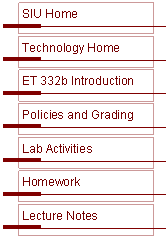

|
Department of Technology |
|
Course Leaning Outcomes |
|
At the end of this course, you will be able to: 1.) Find the voltage current and power in a single phase ac circuit using phasor analysis. 2.) Construct a power triangle for an ac load. 3.) Compute the power factor of an ac load . 4.) Compute the voltages and currents in three-phase delta and wye connected loads and sources . 5.) Solve simple balanced three-phase ac systems . 6.) Identify the types of mechanical loads attached to motors in industry . 7.) Draw the equivalent circuit model of single phase transformers . 8.) Find transformer parameters using open circuit and short circuit tests. 9.) Use the per unit system to perform power system calculations. 10.) Compute transformer efficiency and voltage regulation. 11.) Interpret nameplate data on transformers and ac motors. 12.) Make three phase transformer connections. 13.) Compute load division between parallel transformers. 14.) Explain the operation of three-phase induction motors. 15.) Calculate motor currents, power, speed and torque using an equivalent circuit model. 16.) Measure and calculate motor losses and efficiency. 17.) Connect power meters and measure ac power and power factor. 18.) Conduct no-load and locked-rotor tests to find motor circuit parameters 19.) Explain how synchronous motors operate . 20.) Perform synchronous motor calculation using an equivalent circuit model . 21.) Explain how induction generators operate. 22.) Explain how synchronous motors can be used for power factor correction and calculate their impact. 23.) Explain how synchronous alternators operate. 24.) Perform alternator calculations. 25.) Make three-phase power and energy metering connections and interpret a watt-hour meter reading.
|
|
ET 332b AC Machines and Power Systems |
